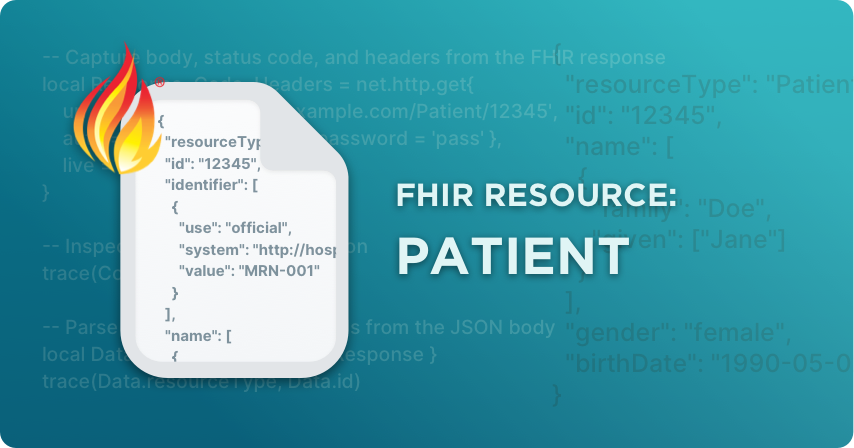
FHIR: Patient Resource
The Patient resource is one of the most important and widely used resources in FHIR. It represents an individual receiving care or subject to health-related services. This resource contains demographic, identifying, and administrative information that can be used across a variety of healthcare systems and workflows.
Because the Patient resource is central to nearly every FHIR-based integration, it often serves as the foundation for linking other data such as encounters, conditions, lab results, or clinical documents.
Purpose of the Patient Resource
The Patient resource provides a standardized structure for storing and exchanging key information about a person involved in healthcare. Its purpose is to ensure that every system describes patients consistently, regardless of platform, vendor, or geographic region.
A Patient resource may include:
- Basic identifiers such as medical record number or national ID
- Names, aliases, and contact details
- Gender and birth date
- Address, communication preferences, and language
- Links to related records, such as family members or previous patient entries
- Information about the managing organization or practitioner
FHIR separates this information into clearly defined fields, making it easier for systems to interoperate without custom mappings or local message formats.
Structure of the Patient Resource
Like all FHIR resources, the Patient resource follows a consistent structure with a resource type, ID, metadata, and data elements. Below is a simplified example in JSON format:
{
"resourceType": "Patient",
"id": "12345",
"identifier": [
{
"use": "official",
"system": "http://hospital.example.org/mrn",
"value": "MRN-001"
}
],
"name": [
{
"use": "official",
"family": "Doe",
"given": ["Jane"]
}
],
"gender": "female",
"birthDate": "1990-05-02",
"address": [
{
"line": ["123 Main Street"],
"city": "Toronto",
"state": "ON",
"postalCode": "M4B1B3",
"country": "Canada"
}
],
"telecom": [
{
"system": "phone",
"value": "555-555-1234",
"use": "mobile"
}
],
"managingOrganization": {
"reference": "Organization/abc-clinic",
"display": "ABC Health Clinic"
}
}This example shows the typical elements included in a basic patient record. FHIR allows for far more detailed data, including marital status, contact relationships, multiple addresses, communication methods, and more.
Relationships to Other FHIR Resources
The Patient resource connects to many other resource types in the FHIR ecosystem. It is the anchor point for most clinical and administrative data flows.
| Related Resource | Relationship Description |
|---|---|
| Encounter | References the patient's visits or care episodes |
| Observation | Records lab results, vitals, or other clinical measurements for the patient |
| Condition | Lists diagnoses or health problems related to the patient |
| AllergyIntolerance | Captures known allergies and sensitivities |
| MedicationRequest | Represents prescriptions and medication orders |
| Organization | Identifies the healthcare facility or provider responsible for the patient |
Because of these relationships, many FHIR queries or integrations begin by referencing a Patient ID. For example, retrieving all Observations for a patient might use a query like:
GET [base]/Observation?subject=Patient/12345FHIR Maturity Level
The Patient resource has one of the highest maturity levels in FHIR, classified as Normative (FMM level 5). This means it is stable, well-tested, and expected to remain backward compatible in future FHIR versions. Organizations can confidently build integrations using the Patient resource without worrying about significant structural changes.
Profiles and Extensions for Patient Data
While the base Patient resource defines a universal model, many organizations and countries extend it with additional elements to meet local requirements.
Examples include:
- Adding ethnicity or race fields for national standards
- Including specific identifiers for insurance or government programs
- Adding preferred pronouns or gender identity extensions
Profiles and Extensions ensure that local data requirements can be met without breaking compatibility with the base FHIR standard.
Real-World Use Cases
The Patient resource is foundational in many real-world interoperability scenarios:
- EHR Integrations: Linking patients between different EHR systems.
- Lab and Imaging Results: Associating clinical results with a patient record.
- HIE Participation: Enabling patient matching and record aggregation across facilities.
- Patient Access APIs: Allowing patients to view or download their health data securely.
Because of its central role, any FHIR implementation that handles clinical data will almost always include the Patient resource.
Other FHIR Resources
Explore other core FHIR resources that work alongside Patient data, such as the Observation and Encounter resources.
Continue reading: FHIR Profiles and Extensions →